|
Japan
Wood Products Prices
Dollar
Exchange Rates of 14th December 2006
Japan
Yen 115.63
Reports
From Japan
Housing starts surge to a over three-year high
Total housing starts surged to 118,360 units in October, up 2% from a year ago and the highest monthly level in more
than three years (see chart). Growth was supported by gains in rental and built-for-sale houses. Wood-based units
accounted for 41% of the total housing starts, down from 44% in the previous month. However, wood structured
houses increased for the thirteenth consecutive month compared with one year earlier. Seasonally adjusted
annual starts reached 1.31 million units, the sixth consecutive month over the 1.2 million level. In Jan-Oct
2006, total housing starts were 4.2% above the pace in 2005.
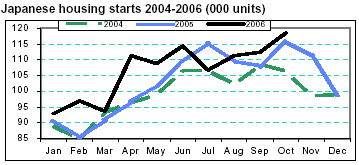
Reduced imports drive plywood supply down in Japan
Total volume of plywood supply fell to 671,000 m3 in September, down 6.1% from August, due to a decline in
plywood imports. Domestic plywood supply rose 14% to 276,407 m3 while imports fell 14% to 394,995 m3. By
import source, 214,000 m3 came from Malaysia (down
2.6%), 114,000 m3 from Indonesia (down 32%) and 53,000 m3 (down 12%) from China. Plywood supply from
Southeast Asia declined due to Ramadan and associated festivities.
Although rising prices for tropical plywood have boosted demand for Chinese poplar plywood, demand was still
exceeding supply during the autumn peak demand season. Japanese prices for structural, concrete forming and thick
plywood remained bullish due to a sizeable backlog of
unfilled orders. Prices for medium and thin panels were stabilizing as inquiries were getting back to normal.
Despite the decline in September, total housing starts were 1% above the pace in 2005. Plywood supply from Southeast Asia was expected to recover in October.
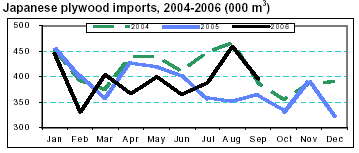
Demand for timber products expected to exceed supply
Japan’s Forestry Agency released its forecast for timber supply and demand for the fourth quarter of 2006 and first
quarter of 2007. Japanese demand for Southeast Asian logs is predicted to decline to 306,000 m3 in the fourth
quarter, bringing the 2006 total to 1.26 million m3, down 12% from 2005. Demand for Southeast Asian lumber is
estimated to fall to 125,000 m3 in the last quarter of the year, for a total 516,000 m3 in 2006, down 8% from 2005.
In contrast, Japanese imports of plywood are predicted to rise to 1.16 million m3 in the fourth quarter, for a total 4.8
million m3 in 2006, up 7% from 2005. Overall demand for Southeast Asian log and lumber products is expected to exceed supply by 1.5% and 3.8% in 2006, respectively.
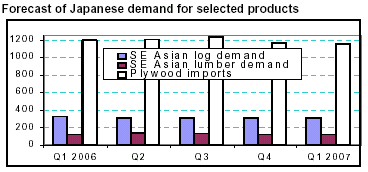
The Forestry Agency also predicts an increasing demand
for and imports of Russian logs. Demand for Russian logs is estimated to reach 4.9 million m3 in 2006, up 2% from
2005. With the gradual shift towards softwood as raw material for plywood production due to shrinking tropical
log supply, the importance of Russian logs and lumber is increasing in Japan.
Japan revises regulation for wood packaging
Japan’s Ministry of Agriculture, Forestry, and Fisheries (MAFF) has adopted new measures for quarantine
inspections of wood packaging materials. These measures will be implemented in April 2007, following a grace
period of about six months. The “Guidelines for regulating wood packaging materials in international trade” were
based on the International Plant Protection Convention’s (IHHP) International Standards for Phytosanitary
Measures (ISPM) No.15. Under the new quarantine regulations, the exporting country is responsible for
carrying out phytosanitary measures and marking the approved packaging material.
Packaging materials should undergo heat treatment (HT, 56°C for 30 minutes minimum) or methyl bromide (MB)
fumigation (48-64 grams per m3 during 24 hours). ISPM 15 targets wood packaging material such as pallets,
crating, packing blocks, drums, load boards, pallet collars
and dunnage, as well as sawdust, wood wool, shavings and others. Packaging material composed of processed wood,
such as plywood, particleboard, OSB or veneer, will not
be subjected to inspections. According to MAFF, unapproved packaging material will not be rejected but
will undergo an inspection to determine the presence or absence of quarantine pests.
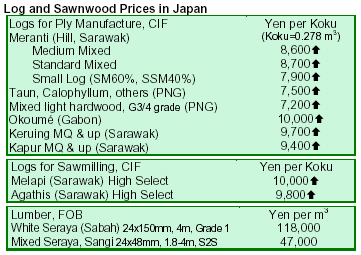
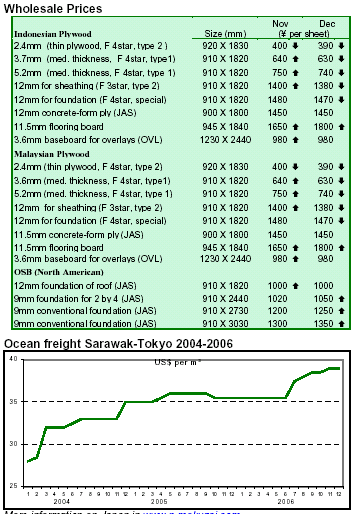
|